Results 1 to 10 of 24
Hybrid View
-
06-05-2019, 05:52 PM #1Senior Member


- Join Date
- Jul 2011
- Posts
- 2,110
Thanked: 459
I don't have any labeled stones except for one of the new ones sold in the states (it's my opinion that in old texts when they talk about light and dark stones, the new ones are definitely novaculite and they meet the characteristics described for a turkish oilstone. They are friable, release grit and slightly less fine than the dark ones).
I have a single dark brown finer stone that would be called turkish no matter what. In my opinion, it's not an ideal stone for a razor. They are basically fine arkansas particle sized stones, but they release particles readily, and if an arkansas stone did that, nobody would use it for razors. They will, of course, work if they have to but if novaculite is desirable, a trans ark, a dan's black, an idwall (sometimes supremely fine..the gray ones with the little black dots on them) is a better choice.
I used the squat thick lighter stone that is still sold now for tools. It's a mid stone for tools, not really a finisher. like 4k if you were forced to stab a grit estimate at it, but the cutting properties are different than synthetic stones.
-
06-05-2019, 05:58 PM #2Senior Member

- Join Date
- Aug 2013
- Location
- NYC, NY
- Posts
- 1,497
Thanked: 169
I just bought one a couple of weeks ago. This is not a modern quarried one, but no label. They are just exorbitantly expensive when labeled.
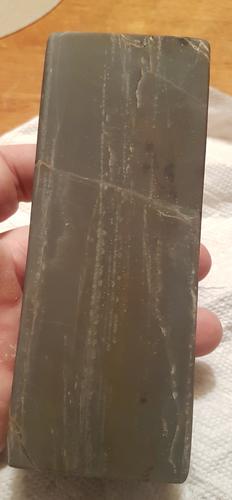

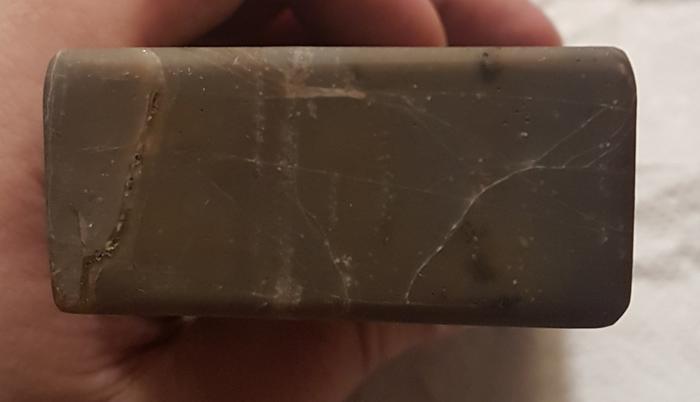
-
06-05-2019, 06:13 PM #3Senior Member


- Join Date
- Jul 2011
- Posts
- 2,110
Thanked: 459
that looks like the lighter colored type, but there are some in betweeners and the proof is in the use. It's instantly evident that my darker stone is finer than my lighter stone, but because it's friable, it will still raise a wire edge whereas a settled in trans ark won't.
Holtzappfel's texts talk about the popularity of these stones because of their ability to grind very hard blades, but most blades at the time were laminated for a combination of reasons. The text talked about how often they all need to be trued, but a razor isn't going to trigger that need like a laminated tool will under pressure on the surface. The soft layer of laminated tools always pulls fresh particles free.
As far as I know,the novaculite is the same as that in an ark stone, but the hardness of both types is about even with a 62c hardness piece of steel. However, fresh loose particles (which is what you get on these under pressure) will allow a stone to reach above its hardness a little bit and grind harder steel (something easy to see if you're willing to slurry an arkansas stone and ruin its surface finish a little bit). The effect is temporary except for in these because they're constantly releasing a little.
re: the price, I haven't looked in a long time. I lucked into my stone in a base for $60, but saw nice black cased unlabeled stones also sell for up to $180 at the same time, and they're sort of a novelty for shaving (perhaps a fantastic pre-finisher, though) and that price has a whole lot to do with why I don't have more of these.
I could be wrong about your stone being the lighter type, too (If i didn't mention it in this post - I got up and came back to it, so I might be repeating something) - they're, of course, drastically different in color - light ones and dark ones - with oil vs. dried out.
-
06-05-2019, 06:17 PM #4Senior Member

- Join Date
- Aug 2013
- Location
- NYC, NY
- Posts
- 1,497
Thanked: 169
I would need to really strip it heavily to see. I have heard of these being cooked in milk as well as soaked in olive oil for extended periods. Former to add surface cohesion I reckon, latter maybe to be like a petroleum pre charged carbo or india given how these like to drink oil.
-
06-05-2019, 06:19 PM #5Senior Member

- Join Date
- Aug 2013
- Location
- NYC, NY
- Posts
- 1,497
Thanked: 169
I mean it's more you really don't want a razor to be that toothy. If you had nothing but the turkish stone, probably would be a good idea to hit a pasted strop of some sort followed by a generous session on linen and leather.
-
06-05-2019, 08:06 PM #6

I've got a turkey stone and was told to keep it wrapped in an olive oil soaked rag when storing it.
Mine doesn't have tags on it either, the tag(s) probably came off decades ago because of all of the oil.
No tags on the box either, just hand writing that says Turk.
It is a fast cutter with chunky grit. Definitely not for a razor or knife. I use it on my adz, froe, splitting wedges, and axes to for bevel resets. It is also good for sharpening shovels, hoes, and lawn mower blades.Some people never go crazy. What truly horrible lives they must lead - Charles Bukowski
-
12-22-2019, 12:10 AM #7Senior Member

- Join Date
- Aug 2013
- Location
- NYC, NY
- Posts
- 1,497
Thanked: 169
Well, that last one above was a really soft stone that was easy to lap. This new monster took me 3 hrs with 120/220 sic on a granite tile. This is the color of this thing btw, it was in simple green a good long while. Need to fine tune the lap, but have high hopes for this one.
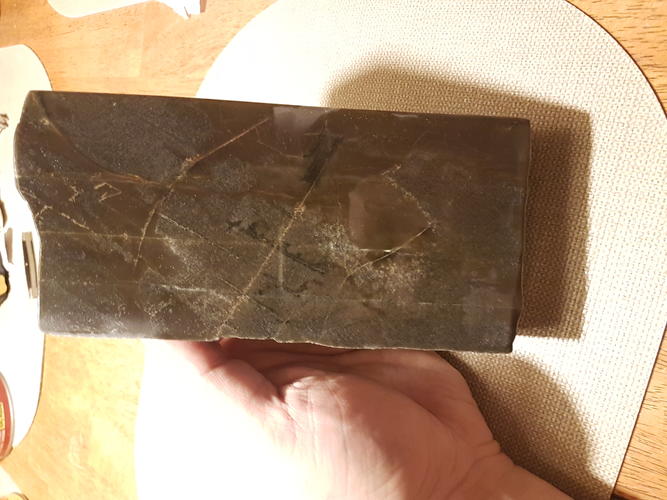
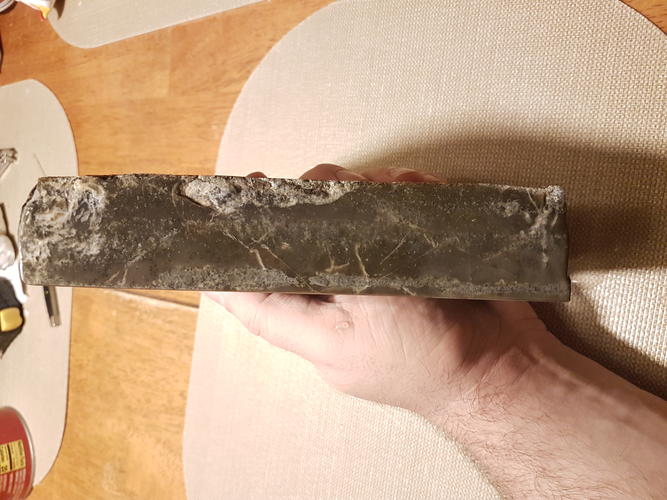
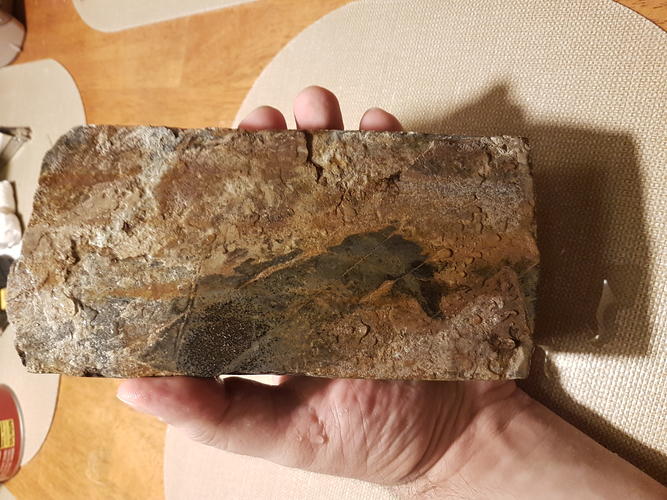
-
06-05-2019, 06:00 PM #8Senior Member

- Join Date
- Aug 2013
- Location
- NYC, NY
- Posts
- 1,497
Thanked: 169
They're not really razor stones imo. It's like using a bulldozer as your daily driver. It will get you moving but you really want a more suitable vehicle.
-
06-05-2019, 06:15 PM #9Senior Member


- Join Date
- Jul 2011
- Posts
- 2,110
Thanked: 459
Pretty much - their particle releasing habits make it so that they've got a bit too much horsepower, and it can be tough to baby them into fine work. They'll never duplicate a good vintage japanese barber hone, but this is of course a hobby where people will go to the ends of the earth to pull out a new silica stone that's not equal to any of the established stones and fiddle-faff with it trying to figure out how to come across the next new secret "fast and fine and sharpens anything".
That said, both the light and the dark types are just super pleasing to the eye when they're oiled. Mine's on my woodworking bench at the moment, even though I don't use it that often and should stuff it in the drawers of my cabinets, it's just nice to look at.


 12Likes
12Likes LinkBack URL
LinkBack URL About LinkBacks
About LinkBacks






 Reply With Quote
Reply With Quote
